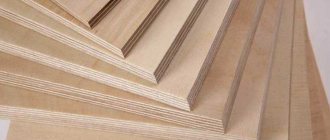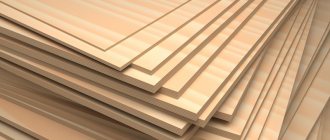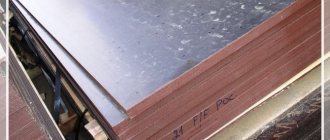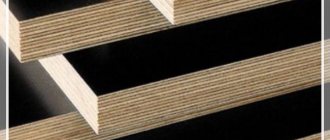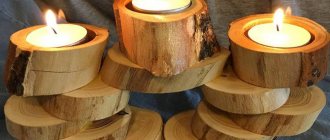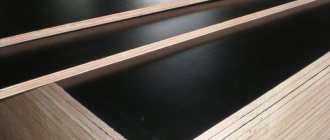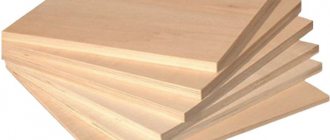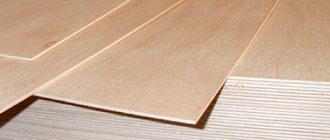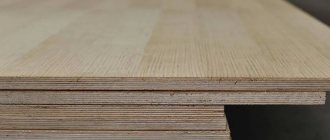Covering plywood with a special film classifies this building and furniture material as laminated. The top coating of the film can be very different: from tarred paper to plastic plates. Conscientious manufacturers must indicate in the labeling what this or that type of laminated plywood is most suitable for.
The difference between laminated plywood and regular plywood
But for all home craftsmen, it will not hurt to know that the process and conditions for making laminated plywood are slightly different from the method for making ordinary plywood boards, which is why the end result is ultimately different.
Below are some characteristics that were defined by GOST of 2010:
- For the production of laminated plywood boards, plywood of the 1st and 2nd grades of the phenol emission class of level E1 is used, and at the same time everything meets strict requirements for the presence of defects on the veneer, the gluing method and the final density of the material.
- The covering for plywood can be made of thermoset plastic or high-strength polymer film. According to the test conditions, the coating should remain unchanged even after 6 hours of boiling, as well as upon contact with liquid concrete and an alkaline environment.
For your information! Bakelite is used as an adhesive and impregnating material, i.e. phenolic-resol resins.
A sheet of laminated plywood, unlike the bakelite variety, is impregnated using the hot method, and it contains less phenol. As a result, we obtain an elastic and at the same time quite durable material, which has a varnished protective layer of polymer. Laminated plywood with a water-resistant effect is more plastic than bakelite board, which has better water resistance characteristics than the laminated sample, but has increased sensitivity to abrasive wear and impacts.
To create the coating of a laminated pitchfork, in addition to textured paper and phenol-formaldehyde resin, polyvinyl chloride films and melamine varnishes are used. Although the technical characteristics of melamine and PVC coatings are slightly worse than FFS, they are indispensable when creating colored plywood sheets. If standard samples have a phenol emission class of E1 according to GOST, then a painted PVC sample emit several times less toxic substances.
According to the technical characteristics of laminated plywood and the method of using GOST, the laminated board is used for exterior finishing and in the manufacture of concrete casting molds. If the same sheet of plywood is painted, then it can be used for interior finishing work, as well as for covering walls in a frame house and as a sublayer for leveling the floor.
It is easy to distinguish standard laminated plywood from painted one - it all comes down to color, since the standard version is dark brown, and colored boards are tinted in shades that are lighter than the original.
Raw materials for plywood
The basis for lamination is plywood made using standard technologies from wood raw materials. Most often, birch and coniferous veneer are used, from which a homogeneous or combined material is made. When different raw materials are combined, the inner layers of a multilayer product are made from one wood, and the outer layers are made from raw materials of other species.
According to tradition, veneer grades are designated by the letters: A, B, C, where A is the best quality and C is the lowest quality. For outer layers, veneers A, AB, B, BB are most often used. According to the updated standard, the designations of which are not always used, the quality of the best veneer raw materials is designated by the letter E, the rest (in descending order) by numbers from 1 to 4. The marking of veneer from coniferous trees contains the letter X.
Note! Humidity indicators are of great importance for ensuring the strength of plywood products, which should be 8% with permissible deviations in both directions of 2%.
Low-grade veneer is not used for the production of laminated plywood, because the process is not economically justified. It makes no sense to put effort into laminating products intended for rough work.
Glue is applied to wood chips with rollers until the raw material is completely saturated. How much adhesive is needed depends on the density, structure and nature of the veneer.
The veneer layers, lubricated with adhesives, are first subjected to light cold pressing, then final fixation is ensured by mechanical compression under conditions of high pressure and temperatures reaching 130 ℃.
The semi-finished product for the production of laminated plywood is subjected to mandatory grinding in order to remove irregularities. The permissible thickness difference ranges from 1/8 to 1/5 of the total thickness of the resulting sheet.
Technical Specifications of Laminated Plywood Board
To designate plywood boards with a special coating, the abbreviation FOB is used, which stands for “cladding birch plywood.” According to the state standard, depending on how the coating is made, there are several brands:
- F- F, a plate coated with a polymer film on both sides. This type of material is considered universal, and it can be used for any wooden sheathing, cladding, upholstery and frames.
- F- W, smooth material with a polymer mesh on the back and a laminated side on the “face”. The standard purpose of this type of material is to use it as a material for flooring and shipping containers.
- SP- SP, double-sided laminated board with a paper underlayer for painting. Used for cladding exterior and interior walls of a house.
- F- SP, board with smooth double-sided lamination. Due to the characteristics of the surface, only painting on one side is permissible.
- F- U , single-sided laminated film board . According to the technical characteristics, the second plane is the same as ordinary plywood with a sanded surface.
In order to ensure that these characteristics remain unchanged during long-term use, the ends of the sheets are pre-painted at the factory with varnishes and acrylic paints. In wholesale trade, you can buy laminated plywood only in this form. And at the stage of pre-sale preparation, the sheets can be redrawn according to the buyer’s request.
Please note that the internationally recognized standard is a sheet measuring 1.22 * 2.44 meters.
Although the dimensional grid is wide, a sheet of plywood is usually produced with a thickness of 0.3 cm to 3 cm. For example, for laminated boards with a thickness of 1.2 cm, the transport or wholesale size is 1.22 * 1.25 meters, and for boards with a thickness at 0.9 cm the size of the plate is half as large. The fact is that the size restrictions are set for a reason - if not observed, the rigidity of the slab will be reduced. For example, a sheet of plywood with a thickness of 0.9 cm and a size of 1.22 * 2.5 meters will sag and deform so much that the protective film can peel off!
To get objective information, you can compare the technical characteristics of ordinary waterproof plywood and laminated board. Based on the technical characteristics studied, we can safely say that plywood brands with a laminated coating are better than standard boards. Since the advantage is expressed only in resistance to aggressive environments and bending strength, when purchasing a material it would be a good idea to familiarize yourself with all the indicators that are given in the quality and hygienic certificate. For example, the latter must contain a record that the material complies with sanitary standards, which will guarantee minimal risks of poisoning from phenol emissions.
Dimensions and weight
The most common ratios are:
- 1220 x 2440 mm (W x D). Depending on the thickness, the weight is: 6 mm – 10 kg; 9 mm – 18 kg; mm – 23.7 kg; 18 mm – 35.6 kg; 21 mm – 41.6 kg.
- 1250 x 2500 mm: 6 mm – 11 kg; 9 mm – 18.6 kg; 12 mm – 25 kg; 18 mm – 37.4 kg; 21 mm – 43.6 kg.
A 6 mm plywood sheet has the minimum dimensions, but some manufacturers produce 4 mm products. The maximum thickness is 40 mm. Such a variety of options allows you to choose the optimal solution for a specific task.
Both domestic and foreign plywood manufacturers try to adhere to uniform product dimensions
Selecting a material for specific applications
This approach is associated with a large number of factors. Products from China and Russia are presented on the domestic market, while material from the Middle Kingdom costs less, but nevertheless complies with GOST. Upon inspection, it was discovered that 80% of the laminated material is made from hardwood, or rather poplar.
If you familiarize yourself with state standards, then it is permissible to produce laminated plywood from some hardwood and softwood species, but only on the condition that the quality of the veneer does not affect the final technical characteristics. According to GOST, poplar can be used, but only for the inner layer, and not for the entire package.
Transport
Laminated plywood is used in transport engineering, railcar and shipbuilding. High strength, resistance to environmental influences, wear resistance and at the same time low weight of the material allow it to be used in the production of bodies, doors, floors of trucks, vans, trailers, buses and trolleybuses, containers, trailers. Plywood is indispensable in the manufacture of railway cars, finishing of yachts, boats and other vessels. Seats on boats, catamarans, and passenger ships are made of laminated plywood. This material provides an optimal price-quality ratio and is considered the most effective in transport engineering.
Differences between laminated plywood sheets by wood type
According to technical characteristics, maple, birch and alder woods are most suitable for creating laminated plywood boards, and the explanation for this is simple - large pores and a high level of lignin content. According to the characteristics of conifers, they even have large internal channels, but they contain hemicellulose substances and resins, and for this reason, phenol-formaldehyde-based varnishes will not penetrate well into the pores of the material.
Poplar is loose and light in structure, has hemicellulose substances in excess, and they also prevent the wood from being saturated with polymers. The substance is destroyed even with a small amount of moisture, and therefore poplar slabs are only suitable for disposable formwork or for finishing the inside of a room.
Sheets of laminated plywood produced at factories in Russia receive the following marking:
- The abbreviation FOB is indicated first.
- After this comes the grade of plywood based on the presence and type of laminated surfaces.
- Phenol class.
- Film size and density are indicated in g/m2.
At the end they write a designation according to GOST, which indicates the technical characteristics of the material.
Finishing facilities
When decorating various types of premises, plywood is used for the manufacture of decorative wall panels, window sills, stationary and movable partitions. Translucent colored films are used for cladding, giving the material the appearance of natural wood.
In addition to its attractive appearance, laminated plywood has excellent heat and sound insulation characteristics, which is why it is used to decorate the walls of public buildings, sports facilities, concert and cinema halls, and children's institutions.
Application area
The main conditions for choosing brands of laminated plywood are the wood and its species, as well as the phenol content and grade. For example, finishing the subfloor requires a protective film that will reduce the release of chemicals.
Often, instead of one sublayer of a thick slab for the base of the floor, a base is made of 2 or 3 layers of laminated mesh plywood with the surface and seam glued with acrylic varnish. For the subfloor, it is permissible to use linden and coniferous boards with standard characteristics. If we are talking about external walls in frame-type buildings, truck bodies and technical fencing, standard plywood sheets, or even second grade, with a phenol emission class of E2, are suitable.
Birch laminate is considered the main material for creating reusable formwork. To objectively assess the capabilities of the slab, a concept such as “structure turnover” is used. The most expensive slabs are able to withstand up to 70 foundation pours.
How to choose plywood for construction work
In terms of its consumer properties, plywood may be preferable to solid lumber. Since it is glued together from several intersecting layers of veneer, the sheet is stronger than ordinary boards of the same thickness. Some brands of plywood have higher moisture resistance and wear resistance. Due to the large size of the slabs, plywood is convenient for creating all kinds of load-bearing flooring, as well as rough and finishing sheathing. In terms of scope of use, this material has only one competitor - OSB.
This article will tell you how to choose plywood for a construction site.
What species is the veneer for plywood made from?
It should be noted that coniferous or hardwood plywood is called by the type of species its outer layers are made of. That is, the veneer on top can be made from deciduous veneer of birch, linden, poplar, alder... and inside it is possible to use pine needles (pine, spruce, cedar... veneer). Slabs that contain different rocks are called combined.
Based on multiple tests, birch plywood is approximately twenty percent stronger than a homogeneous product glued together from pine/spruce veneer. And it will be almost twice as much as aspen slabs.
Such results are largely explained by the increased density of birch plywood compared to coniferous products. In numbers, we have an average of 700 kg/m3 versus 560 kg/m3, respectively. High density is not only good resistance to bending and stretching. This is also wear resistance, the ability to reliably hold loaded fasteners, etc.
But not all hardwood plywood is created equal; for example, a Chinese product made from poplar has a density of about 500 kg/m3. And sometimes the density drops to 350-400 kilograms per cubic meter. Moreover, even more problems with such sheets are related to environmental safety, since they usually contain many times more harmful substances than the maximum concentration established by regulations. Poplar is softer than birch and is more afraid of water.
Considering its low cost, Chinese poplar plywood (for example, laminated FOF) has a right to exist; it will more than earn its money when creating formwork panels or assembling flooring for scaffolding.
Variety of plywood
Softwood boards are described in GOST 3916.2-96 “General purpose plywood with outer layers of softwood veneer. Technical conditions".
Hardwood boards are described in GOST 3916.1-96 “General purpose plywood with outer layers of hardwood veneer. Technical conditions".
Aesthetic properties and characteristics
In this section I would like to dwell on the various color solutions of this material. Even in the photo he looks inimitable.
Most often, the coating is presented in the following colors:
- brown;
- dark brown transparent type;
- dark brown opaque type;
- chestnut.
Multi-colored material
However, these are not all the colors of laminated plywood. Their true number is great. Of course, for example, white is distinguished by its aristocracy and can be used for any purpose.
But there are other popular shades and colors:
- black;
- yellow;
- burgundy;
- lilac;
- gray and many others.
Decorative plywood is divided into two main types and can have the following indices in its marking:
- F - smooth;
- W – embossed.
